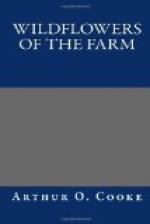Both the stems and leaves are covered with tiny hairs. These hairs are really small hollow tubes ending in a sharp point. When the Nettle stings you it first pricks the skin with these sharp points, and then a drop of poison falls from the tube into the wound the point has made.
If you happen to get stung by a nettle do not bathe your hand with cold water; that will only make the pain worse. While you are waiting for the pain to pass off remember that in India there are nettles whose sting causes great pain which lasts for several days. You might be much worse off, you see!
The small greenish-yellow flowers of the Stinging Nettle grow in long feathery clusters on stalks which spring from the main stem close to a pair of leaves.
The young leaves of the Nettle are said to be very nice boiled as vegetables; I cannot say that I have ever eaten them myself. Years ago country people used to take a great deal of nettle tea as medicine in spring. Nowadays they seem to prefer patent medicines from the chemist’s shop. A dye is made from the roots of the Nettle, and another dye from the stem and leaves. The young leaves or tops, when chopped up, are good for poultry, especially for turkeys. So nettles are useful, you see—not merely stinging weeds. The Nettle, too, is a relation of the hemp plant from which we get our string and ropes.
[Illustration: Traveller’s Joy.]
You may sometimes see or hear of the White, Red, and Yellow Dead Nettle, but these are not really nettles at all. Their leaves are somewhat similar, but they are quite different plants.
Hanging over this great patch of nettles by the hedge there is another weed, the Traveller’s Joy, or Old Man’s Beard. Its stem has climbed not only up the hedge, but high into a hawthorn bush which stands there. It has many small white feathery flowers with a pleasant scent. On each leaf stem there are usually five leaflets, one at the end of the stem and two pairs lower down. These leaf stems are long and tough, and it is chiefly by them that the plant can climb as it does; they twine round any branch or twig they touch, and give the Traveller’s Joy a firm support. I have seen trees in woods covered with this plant to a height of twenty feet from the ground.
In the autumn and early winter you would admire the Traveller’s Joy as much as you do now. The flowers will certainly be gone, but each seed which takes the place of a blossom will have a little plume of silky white threads attached to it—a sort of feathery tail. These serve as wings by which the seeds are often carried long distances by the wind. The seeds of some other plants which we shall see have something of the same kind.
There is another climbing plant in the hedge, the Large Bindweed or Convolvulus. To look at it, however, we will go round into the garden where there is more of it than Mrs. Hammond cares to see. It is certainly a beautiful plant, with its large three-sided pointed leaves, and its great pure white bell-shaped flowers—something like the mouth of a trumpet.




